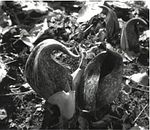A Woodland Plant That Deserves More Respect
Around the end of March signs of spring start appearing as snowdrops, winter aconite and wild crocus pop up their welcome heads. It’s also time for the arrival of skunk cabbage. Walking by the swampy area just west of 9W on Oak Tree Road, you should be able to spot clumps of them stretching a few inches above the murky surface. Funny, in their early stage, they bring to mind Audrey II, the man-eating plant in the 1986 cult pop musical film, A Little House of Horrors.
Eastern Skunk Cabbage, a North American native, gets its name from the pungent odor it emits, especially when bruised. Bees, beetles and flies don’t seem to mind; settling on the plants, they pick up pollen from its flowers and transfer it from one plant to another. American Indians discovered its medicinal benefits and used skunk cabbage for a range of problems from coughs to skin sores. Most animals though avoid skunk cabbage because of the burning sensation it causes when eaten.
A member of the Arum family as are calla lily and Jack-in-the-pulpit, skunk cabbage or symplocarpus foetidus, a mouthful of a latin name, grows in wet, boggy places. The largest of woodland wildflowers, it has a massive central root system. This plant’s most remarkable characteristic is its ability to produce and maintain considerable heat, allowing it to bloom even when the ground is frozen. Over a twelve-day period, this amazing wildflower can regulate the temperature, raising it by as much as fifteen to thirty-five degrees above the air surrounding it. Smart little honeybees use the plant to warm up on cold days on flights between hive and nectar sources.
Skunk cabbage flowers develop before its leaves. When the plant first emerges, a maroon-colored modified leaf, frequently mottled with yellow, forms a cup around a fleshy finger-like yellow spike with petal-less flowers. This hood-shaped leaf curves inward to a tip to protect the spike. As the flowers mature, the leaf-like form unfolds to allow pollinators to enter, then withers soon after the plant has flowered.
Nestled next to the spike, you can usually see a pale green bud. The tip of leaf shoots, these tightly scrolled leaves will start to grow by late spring when the plant has flowered, unfolding in a spiraling pattern and eventually becoming large bright green fleshy leaves on stalks that can extend out to three to four feet. By mid-June the leaves begin to decay. After pollination in mid-summer the flower heads swell and develop green berries, each containing two seeds. By August, the fruit head falls apart, scattering its seeds on the ground, where they are ready to germinate into new plants the next growing season.


